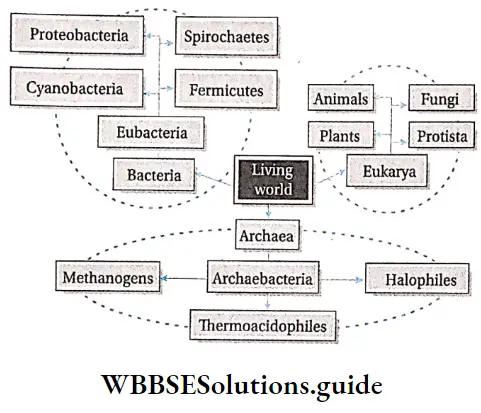Sequential Development Of Classification System Of Living Organisms
- Initially, biologists divided all living things into two large groups or kingdoms—the plant and the animal. However there were certain limitations, so this classification system was discarded. Gradually, three and four-kingdom classification systems were proposed.
- But they too were discarded due to some reason. With time, five and six-kingdom classification systems were proposed. Today, most biologists favor the five-kingdom system of classification.
Two kingdom classification:
The two-kingdom system of classification was proposed by Carolus Linnaeus. As mentioned before, it has two large groups— Plant Kingdom and Animal Kingdom. This classification system was developed based on locomotion and food habits seen in organisms. A.L. de Jussieu gave the major subdivisions of Kingdom Plantae. The major phyla of Kingdom Animalia were given by G.L.Cuvier.
Read and Learn More: WBCHSE Notes for Class 11 Biology
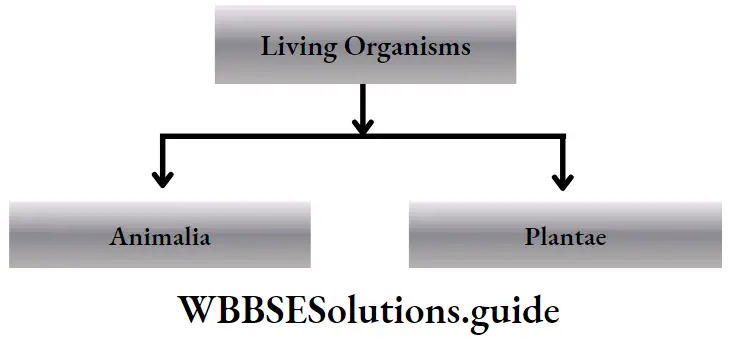
Drawbacks: This system included all plants and animals, without discriminating the eukaryotes and prokaryotes, unicellular and multicellular, autotrophic and heterotrophic organisms.
This system also failed to classify organisms that did not fall under either of these two groups. However, this two-kingdom system of classification was used for a long time but was eventually replaced by a three kingdom system.
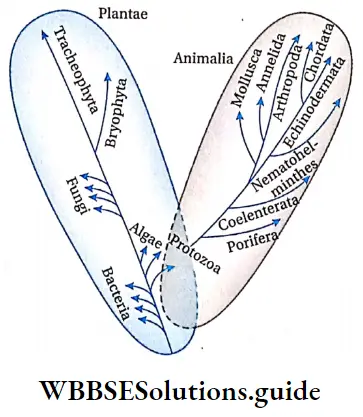
Three kingdom classification:
With the progressive development of the microscope, several microscopic organisms were discovered. These microorganisms were neither plants nor animals and so needed to be placed in another group. Hence, German; Scientist Ernst Haeckel (1866) introduced another kingdom called Protista. Haeckel included bacteria and cyanobacteria in this group. This modified classification system came to be known as the kingdom classification system.
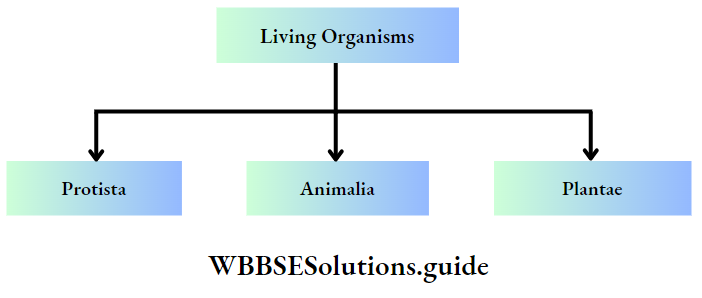

Drawbacks: This system failed to distinguish between prokaryotic and eukaryotic organisms. Unicellular and multicellular organisms were still placed in the same group under this system.
Four kingdom classification:
With the discovery of electron microscope, the microorganisms could be observed better. As a result, prokaryotic and eukaryotic cells could be distinguished clearly. Based on this, Herbert F. Copeland proposed the four-kingdom classification system in 1938. He separated prokaryotic bacteria and blue-green algae from kingdom Protista and placed them under another kingdom called Monera.
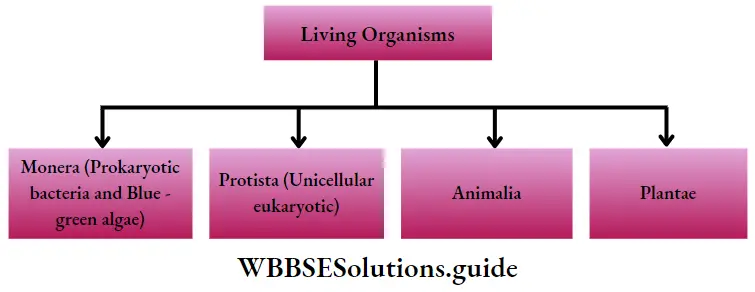
Towards the beginning of 1960s, Stanier and Van Niel introduced another category (also called rank) above the Kingdom in the classification system. This category or rank came to be known as the Superkingdom or Empire. The living world was divided into two Superkingdoms— prokaryota and eukaryota.
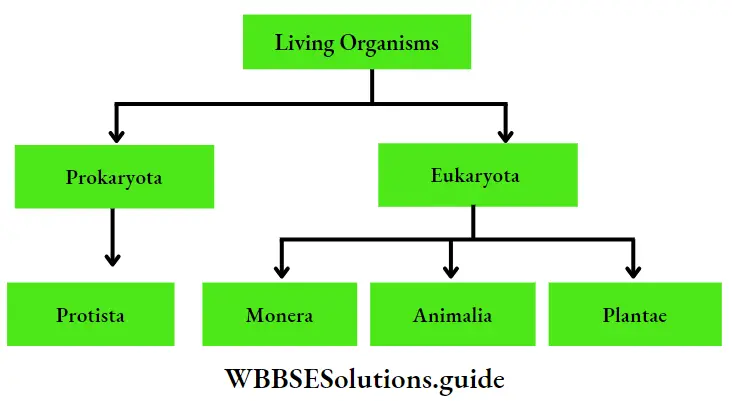
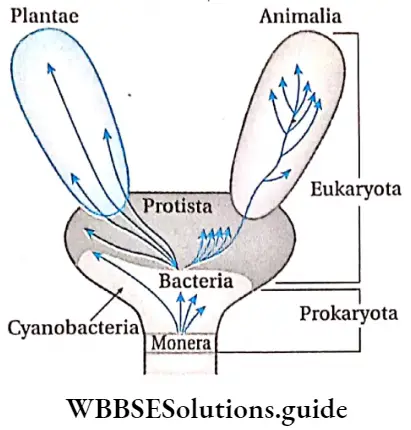
Five kingdom classification
- In 1969, R.H. Whittaker introduced the five-kingdom system of classification. According to Whittaker, all protists must be unicellular. He divided this kingdom Protista into two parts called subkingdoms.
- One subkingdom included all uninucleated (eukaryotic) organisms—protozoans, diatoms, euglenoids, and many other microscopic organisms. Non-nucleated (prokaryotic) organisms, on the other hand, were included in the other subkingdom.
- This group included both the true bacteria and the cyanobacteria. Cyanobacteria is an important group of prokaryotes that carry out oxygenic photosynthesis. They are often referred to as blue-green algae.
- Whittaker excluded all of the fungi, marine algae, and other multicellular organisms from kingdom Protista and placed them in separate groups. This system of classification is called the Five Kingdom classification.
Basis of five kingdom classification: The previous classification systems (two, three and four kingdoms) had certain drawbacks. Many of such issues were resolved through Five kingdom classification system. The basis of classification under this system is as follows—
- Complexity in body structure,
- Complexity in cellular organization,
- Mode of nutrition,
- Variation in ecosystem,
- Phylogenetic relationship.
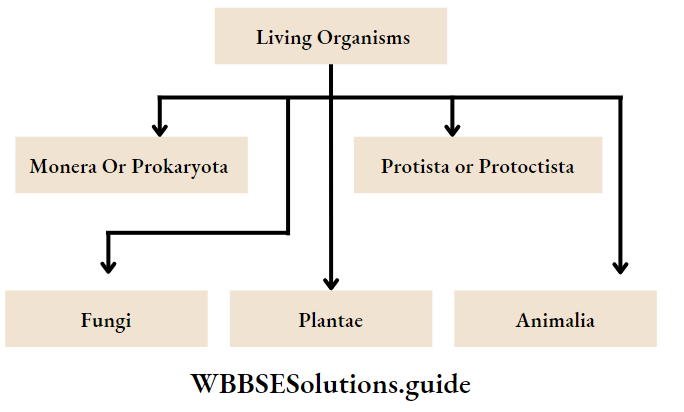
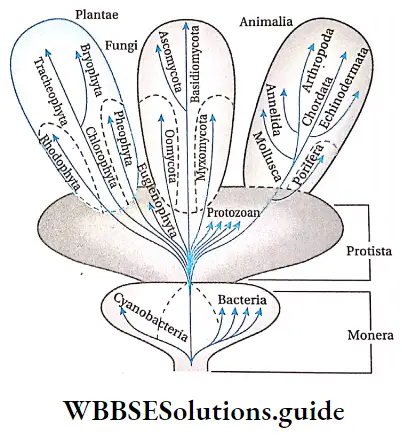
On the basis of the above-mentioned features, living organisms were arranged hierarchically into three levels—
- Prokaryotic organisms (placed under kingdom IVlonera);
- Eukaryotic, unicellular organisms (placed under kingdom Protista); and
- Eukaryotic, multicellular organisms (placed under kingdoms Fungi, Plantae and Animalia).
Comparison between the Five Kingdoms:
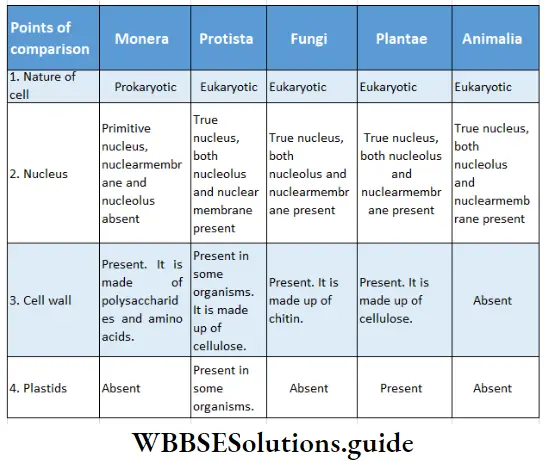
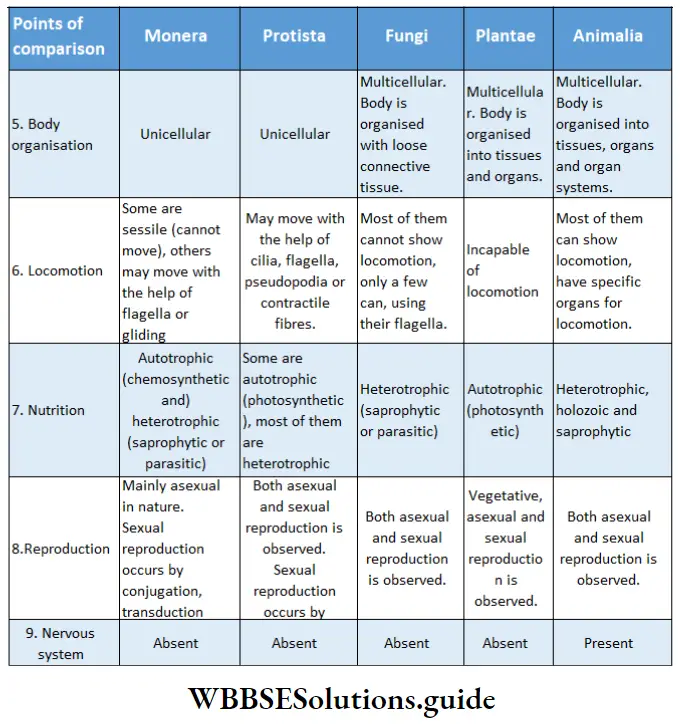
Merits and demerits of five kingdom classification
The five kingdom system of classification system has both merits and demerits.
Merits:
- Monera has been placed as a separate kingdom. This is correct, as the members of Monera have characteristic features different from other unicellular organisms.
- Bacteria, fungi and some algae were eliminated from Kingdom Plantae. This has led to proper study of the evolution of plants, in particular.
- The group protozoa has been separated from Kingdom Animalia, which makes kingdom Animalia more homogeneous. Now the kingdom contains more organisms with similar features.
- The groups of fungi and slime mould have been placed in a Kingdom. This is justified because they are totally different from other primitive prokaryotes like algae and protozoans.
- The kingdom Plantae and Animalia are now more homogeneous groups than they were in the previous classification systems. This is due to the fact that now they contain only plants and animals, respectively.
- The five kingdom classification puts stress on cellular organisation and modes of nutrition, both of which are basic characteristics of life.
- It is the most accepted system of classification. This is mainly because the different groups of organisms have been placed according to their phylogenetic nature.
Demerits: The five kingdom classification has certain demerits as well, particularly with reference to j the lower forms of life. These are—
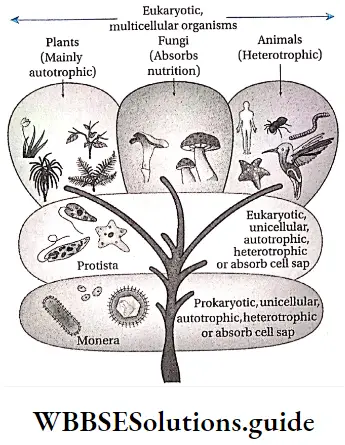
- Different types of algae have been introduced under three separate; kingdoms, which is wrong. For example, cyanobacteria has been included under Monera, while bacillariophyceae and dinophyceae under Protista, and red algae, brown algae and green algae under Plantae. This is not acceptable as all of these belong to the same group—algae. Hence, these should not be placed in different kingdoms.
- Kingdom Protista is made up of different types of organisms. This makes the kingdom more heterogeneous, hence complicates the relation between the organisms.
- Chlamydomonas sp., inspite of being unicellular, has not been included under Protista as it closely resembles other members of green algae.
- Red algae and brown algae, though placed under Kingdom Plantae, are quite different from the other members of the kingdom.
- Viruses have not been placed under any kingdom in this system of classification.
Six kingdom classification
Cavalier Smith was first to propound the six kingdom classification in 1998. This system includes six kingdoms—bacteria, protozoa, chromista, plants, fungi and animals. The table below depicts different systems of classification as propounded by different scientists.
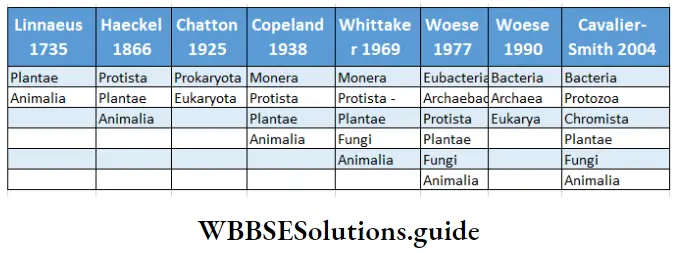
- Three domain classification: Towards the mid 1970s, scientists began classification of living organisms according to their genetic constitution. They placed organisms, that originated from the same ancestor, within the same group.
- This led to the introduction of three domain classification system. It was put forth by American microbiologist, Carl Woese in 1990. In this system, the living world is divided into three groups or domains— Archaea, Bacteria and Eukarya.
- Basis of classification: While searching for new unicellular organisms, Carl Woese discovered certain microorganisms. These organisms could survive under extreme conditions such as acid lakes, hot water springs, etc.
- He named these as archaebacteria. Analysis of their DNA structure showed similarities with that of the eukaryotes but dissimilarities with prokaryotes. Later he named this domain as Archaea.
- Classification: Basically, it is a system of classification of living organisms into three domains based on the differences in their 16S rRNA genes. According to Carl Woese, all organisms have evolved from a primitive organism or a progenote.
- According to the genetic differences, he classified the kingdom Monera into eubacteria (mainly bacteria) and archaebacteria (presently archaea). The rest of the eukaryotic organisms were placed under the domain Eukarya. Each domain is further divided into several kingdoms.
